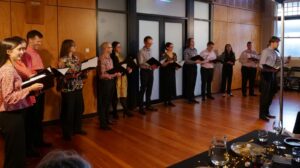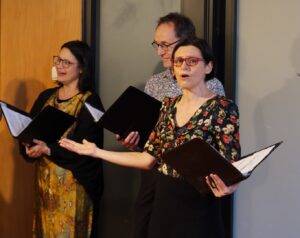NZ Trio – Magnifique
Schubert – Notturno in E flat major (D897)
Pēteris Vasks – Episodi e canto perpetuo (1985)
Linda Dallimore – Self-portrait (2024)
Saint-Saens – Piano trio No 2 in E minor (Op. 92)
St Andrew’s on The Terrace,
Friday 2 May, 7.30 pm
The night of the concert was cold and wet. The big southerly storm that hit on Wednesday was still in force, so the small audience in St Andrew’s was disappointing but not surprising. This review is dedicated to everyone who let the weather keep them away from a stunning concert. Let me tell you what you missed!
After several years of change, NZ Trio has now reached its new form. Ashley Brown retired from the Trio in February, the last of the founding members to leave. Matthias Balzat was billed as ‘guest cellist’, but the exciting news – announced during the concert – is that he will be taking the position permanently from 2026.
Matthias Balzat is a phenomenal cellist. I first heard him perform as a soloist with Wellington Youth Orchestra when he was 17, just about to head to Germany for advanced study in cello, already with a bachelor’s degree from Waikato and a swag of awards to his name. He was already a commanding musical presence with dazzling technique. Since graduating from the Robert Schumann Hochschule, where he was taught by Pieter Wispelwey, he has been freelancing in Germany. The NZ Trio gig, he told us, gives him an opportunity to return home.
How would he fit in to the Trio? Any fears I may have had were dispelled as soon as the Schubert began. The Nocturne is a familiar work, an exquisite piece that Schubert may have intended as the slow movement for his first piano trio. The tempo was slow, but never too slow. The effect was of an unfurling of beauty, played with high seriousness. It was as though this was the most important music Schubert ever wrote, and the most poignant. He finished it only months before he died, and never heard it performed. I feel certain he would have loved this performance.
The next work on the programme was a piece by the Latvian composer, Pēteris Vasks, written in 1985. This was its New Zealand première. Vasks trained as a violinist at the Riga Conservatory and played double bass in various Latvian orchestras before moving to Lithuania to study composition with Valentin Utkin. As the son of a Baptist pastor, he wasn’t permitted to do this in Latvia, because Baptists were repressed by the Soviets.
He began to compose after hearing a piano arrangement of Messiaen’s Quartet for the End of Time, thanks to his piano teacher at the Vilnius Conservatory. His response was immediate: ‘It was like a lightning flash to me – that music can be like this!’ But his works were unknown outside the Baltics until after the fall of the Berlin Wall, when fellow Latvian Gidon Kremer started touring his violin concertos in the West.
The Episodi e canto perpetuo is dedicated to Olivier Messiaen. That provided some kind of emotional preparation. This is a powerful and inventive work. The programme notes suggested a battle between light and dark, but that doesn’t do it justice. It requires virtuosic playing from all three instruments, with two frenzied ‘burlesques’ separated by a ‘monologue’. The whole work is a kind of journey from a dark and scary opening movement, with a bleak wash of sound from the strings, moving higher and higher into a kind of frenzy. The Misterioso that followed uses prepared piano and light glissandi on the strings to suggest a ghostly calm. The Unisono began with strong piano chords and a cantabile theme from the strings, building to confidence, then aggression. The effect is loud and humourless, with frightening crescendi. Vasks described the first Burlesque as ‘ironic, almost grotesque’. I thought he must have been listening to Shostakovich, so sardonic was it – or perhaps that was life under the Soviets. The second burlesque, even more frenzied, Vasks called ‘the black culmination of the opus. Road to nowhere.’
After all the terror, in the seventh movement, the first violin sang like a nightingale in a ruin, trilling over blackened stones and empty spaces. Could there be a resolution, my notes asked? The cello, high and sustained, said yes, the plangent violin whispered that there was hope. A shift to the major, like a shaft of sunlight, high and sweet.
This is an important work. If it is his response to Quartet for the End of Time, the man is a genius, because he has transcended it. But there is more. Over the last 40 years Vasks has written three symphonies, other works for orchestra, concerti for violin, viola, cello, and flute, half a dozen string quartets, many choral and chamber works, and several works for violin, cello, and piano. I very much hope that NZ Trio programmes a couple of those. Soon, please.
After the interval, a small, introspective work by New Zealander Linda Dallimore (‘an award-winning composer, flutist, and teacher’) currently based in Los Angeles, where she is completing a DMA at the University of Southern California. It’s a pleasant enough work, ‘inspired by the composer’s first months in LA’, short and rather slight, but full of interesting effects. Unfortunately, coming after the emotional complexity of the Vasks piece, even separated by the interval, it sounded a bit self-absorbed, clever but trivial.
The last work in the programme showed off all three players to good effect, but especially the glorious Somi Kim. Saint-Saens was a remarkable pianist, a prodigy who performed the complete Beethoven sonatas from memory by the age of 10. He wrote this work as a holiday project, in the spring of 1892, 30 years after his first piano trio, to show what the piano is capable of. It is a masterpiece. Somi Kim was in her element, showing us delicacy and powerful pianism, as required. Saint-Saens’ piano writing is demanding and virtuosic, and Kim played like an angel.
The NZ Trio has been regarded as a national treasure for some time now. I have always enjoyed its programming. With Balzat joining the superb Kim and Hall, it has turned into a trio of international consequence. As well as being intellectually adventurous and musically fearless, the players together have the most glorious sound, warm and perfectly unified. I am truly sorry that their first concert was heard by an audience of only a hundred or so. But take my word for it: you won’t want to miss the other concerts in their 2025 season. Now would be a good time to book.
 Director Michael Stewart in front of The Tudor Consort
Director Michael Stewart in front of The Tudor Consort From left: Alexandra Granville, Keith Small, Rebecca Stanton (in front).
From left: Alexandra Granville, Keith Small, Rebecca Stanton (in front).